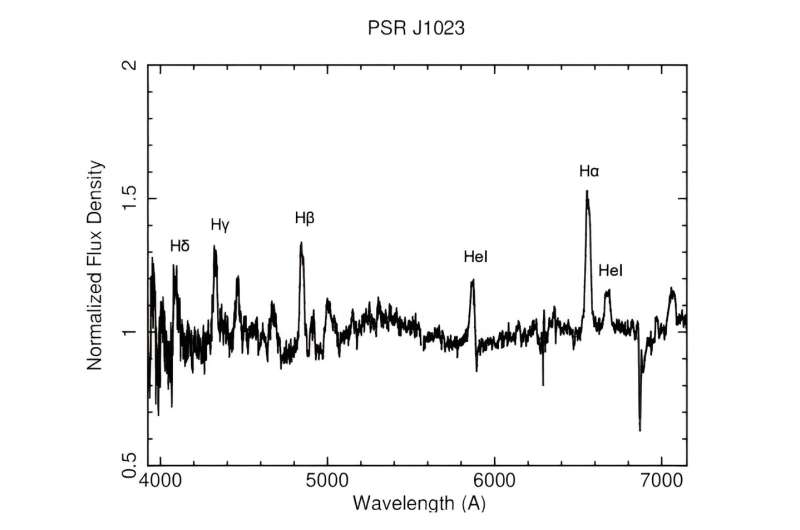
The mean spectrum of J1023 is normalized to continuum emission. The emission lines studied in this work are highlighted. Credit: Mesa et al., 2024.
Using the Gran Telescopio Canarias (GTC), astronomers in Italy and Spain have made high-time-resolution optical spectroscopic observations of a transiting millisecond pulsar named PSR J1023+0038. The results of the observation campaign were published on the preprint server on September 19 arXivgives essential information about the nature of this pulsar.
Pulsars are highly magnetic neutron stars and emit a beam of electromagnetic radiation. The fastest pulsars with rotation periods of less than 30 milliseconds are known as millisecond pulsars (MSP). Astronomers think they form in binary systems when the more massive component first becomes a neutron star, which then spins up due to accretion of material from the secondary star.
So-called transition millisecond pulsars (tMSPs) transition back and forth between a spin-forced radio pulsar state (the “pulsar state”) and a state characterized by X-ray pulsations and accretion disk features in optical spectra. (‘disk mode’). They are generally rare, as only three tMSPs have been identified so far.
One of them is PSR J1023+0038 (or J1023 for short), which was first identified two decades ago. The pulsar has a rotational period of 1.69 milliseconds, while its orbital period is approximately 4.75 hours. The companion star in the system is a star of spectral type G5.
Previous observations of J1023 have shown that it switches between an X-ray state and a spin-fed radio pulsar phase. Now, a team of astronomers led by Marco Mesa of the University of Milan in Italy has used the GTC Optical System for the Low-Intermediate Resolution Integrated Imaging and Spectroscopy (OSIRIS) instrument to investigate the nature of this pulsar and its behavior
Observations showed that J1023, like other tMSPs, exhibits flux variability on short time scales (tens of seconds) in all bands. In addition, this study found evidence of a significant change in emission line properties (equivalent width and half-full width) on a time scale of several minutes. This finding is the first time that variability in the spectral line properties of a tMSP has been observed in such short time intervals.
According to this study, the episodes of variability observed in the continuum, equivalent width and full half maximum width appear irregular and are not correlated with each other. This makes the origin of such episodes unclear.
Observations also showed that the emission lines of the Balmer series and helium in most cases show a double-horned emission profile. This indicates the presence of an accretion disk and therefore it is likely that J1023 was in its disk state during the observational campaign.
In the concluding remarks, the authors of the paper add that simultaneous multi-wavelength observations should be performed in order to assess the possible correlation between the variability in the emission line properties and the mode change phenomenon in J1023.
More information:
MM Messa et al., High time-resolution optical spectroscopic observations of the transient millisecond pulsar PSR J1023+0038, arXiv (2024). DOI: 10.48550/arxiv.2409.12893
Magazine information:
arXiv
© 2024 Science X Network
quote: Observations explore the nature of the transitional millisecond pulsar PSR J1023+0038 (2024, September 28) Retrieved September 29, 2024 from https://phys.org/news/2024-09-explore-nature-transitional-millisecond -pulsar.html has been restored.
This document is subject to copyright. Except for any fair dealing for the purpose of private study or research, no part may be reproduced without written permission. Content is provided for informational purposes only.
#observations #investigate #nature #transient #millisecond #pulsar #PSR #J10230038